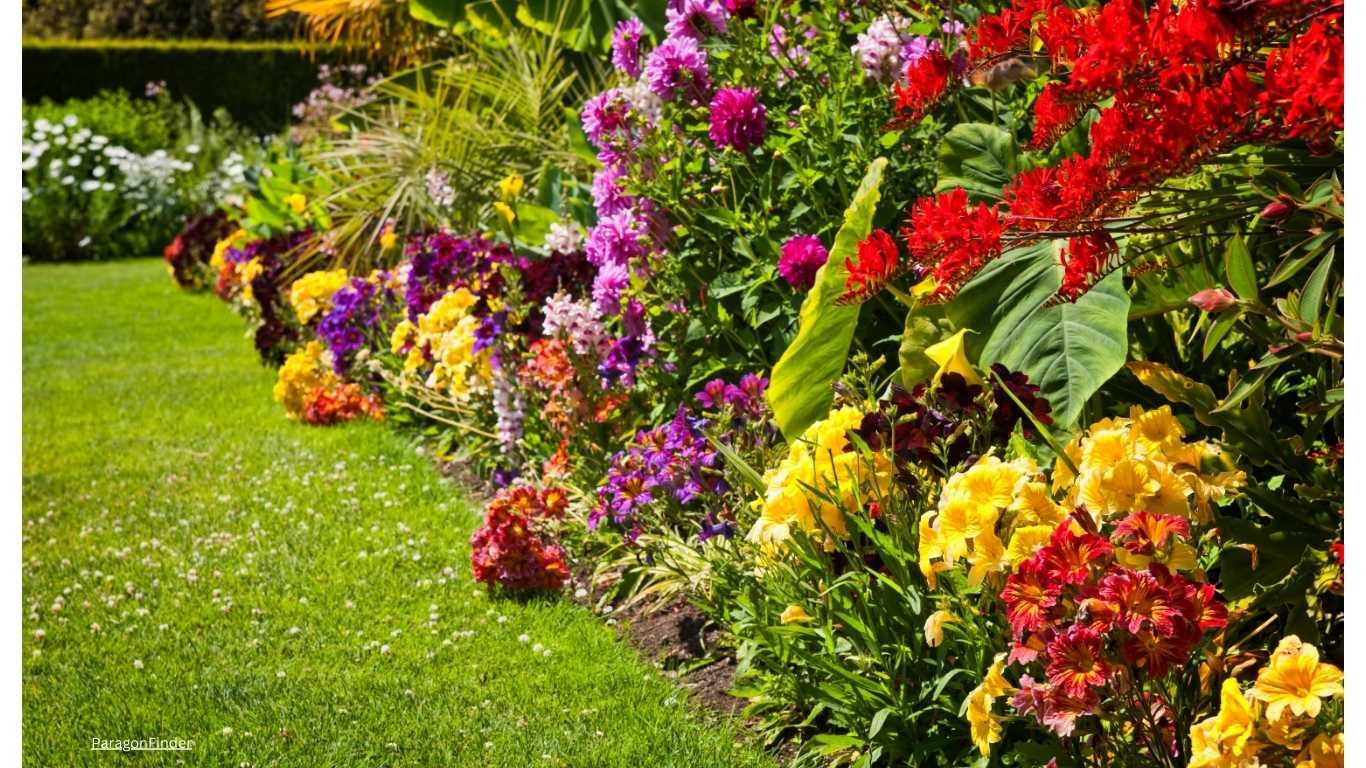Gardening is a rewarding hobby, and growing flowers can bring joy and beauty to your outdoor space. For beginners, choosing the right flowers is crucial to ensure success without much hassle. Here are 15 easy flowers to grow for beginners, along with detailed tips and personal insights to help you cultivate a flourishing garden.

1. Marigolds
Marigolds are vibrant, hardy flowers known for their bright orange and yellow petals. They are incredibly easy to grow and are excellent for beginners due to their resilience.
- Growing Conditions: Marigolds thrive in full sun and well-drained soil. They are drought-tolerant and can withstand various soil types.
- Planting Tips: Sow seeds directly in the garden after the last frost or start indoors 4-6 weeks before planting outside. Space the plants 8-18 inches apart, depending on the variety.
- Personal Tip: Plant marigolds around vegetable gardens to deter pests like aphids and nematodes naturally.
2. Zinnias
Zinnias are one of the easiest flowers to grow from seeds, offering a burst of color in the garden. They come in a variety of shapes and colors, making them a favorite among gardeners.
- Growing Conditions: Zinnias prefer full sun and well-drained soil. They are heat-tolerant and require minimal care once established.
- Planting Tips: Direct sow seeds after the last frost, spacing them 4-24 inches apart based on the variety. Water regularly but avoid overhead watering to prevent mildew.
- Personal Tip: Deadhead spent blooms to encourage continuous flowering throughout the season. Zinnias make excellent cut flowers for bouquets.
3. Sunflowers
Sunflowers are iconic and cheerful flowers that are perfect for beginners. They grow quickly and can reach impressive heights, making a striking statement in any garden.
- Growing Conditions: Sunflowers need full sun and well-drained soil. They are relatively drought-tolerant once established.
- Planting Tips: Sow seeds directly in the garden after the last frost, spacing them 6 inches apart. Thin to 12-18 inches apart once seedlings are established.
- Personal Tip: Choose a sunny spot and provide support for taller varieties to prevent them from toppling over. Harvest seeds for a tasty snack or to feed birds.
4. Cosmos
Cosmos are delicate, daisy-like flowers that are easy to grow and thrive in poor soil conditions. They attract butterflies and bees, adding life to your garden.
- Growing Conditions: Cosmos prefer full sun and well-drained soil. They are drought-tolerant and do well in hot, dry climates.
- Planting Tips: Sow seeds directly in the garden after the last frost. Space them 12-18 inches apart. Cosmos can self-seed, so you may find them returning year after year.
- Personal Tip: Sow seeds in clusters for a more natural look. Cosmos are great for pollinator gardens and make lovely cut flowers.
5. Pansies
Pansies are cool-weather favorites with charming, face-like blooms. They are perfect for early spring and fall gardens, adding a splash of color when many other flowers are not in bloom.
- Growing Conditions: Pansies prefer cool temperatures, well-drained soil, and partial shade. They can tolerate light frosts.
- Planting Tips: Start seeds indoors 8-10 weeks before the last frost or purchase transplants. Space them 6-9 inches apart.
- Personal Tip: Plant pansies in well-drained soil and provide partial shade in hotter climates. Deadhead spent blooms to encourage continuous flowering.
6. Snapdragons
Snapdragons are known for their unique, dragon-shaped flowers. They are easy to grow and come in a variety of colors and sizes, making them a versatile addition to any garden.
- Growing Conditions: Snapdragons prefer full sun to partial shade and well-drained soil. They can tolerate light frost and thrive in cooler weather.
- Planting Tips: Start seeds indoors 6-8 weeks before the last frost or sow directly in the garden in early spring. Space plants 6-12 inches apart.
- Personal Tip: Pinch back the stems to encourage bushier growth and more blooms. Snapdragons are excellent for cutting gardens and last well in vases.
7. Petunias
Petunias are versatile flowers that can be grown in containers, hanging baskets, or garden beds. They bloom profusely and come in a wide range of colors and patterns.
- Growing Conditions: Petunias thrive in full sun and well-drained soil. They require regular watering, especially in containers.
- Planting Tips: Start seeds indoors 10-12 weeks before the last frost or purchase transplants. Space them 10-12 inches apart.
- Personal Tip: Regularly water petunias and use a liquid fertilizer every couple of weeks to keep them thriving. Deadhead spent flowers to encourage new blooms.
8. Nasturtiums
Nasturtiums are edible flowers that add a pop of color to gardens and salads alike. They thrive in poor soil and need minimal care, making them ideal for beginners.
- Growing Conditions: Nasturtiums prefer full sun to partial shade and well-drained, poor soil. They are drought-tolerant once established.
- Planting Tips: Sow seeds directly in the garden after the last frost, spacing them 10-12 inches apart. Nasturtiums can also be grown in containers.
- Personal Tip: Use nasturtiums as ground cover to suppress weeds and enjoy their peppery leaves in your dishes. The flowers make a beautiful garnish for salads.
9. Calendula
Calendula, also known as pot marigold, has bright yellow and orange blooms. It is easy to grow and has medicinal properties, making it a useful addition to any garden.
- Growing Conditions: Calendula prefers full sun to partial shade and well-drained soil. It can tolerate light frost and cooler temperatures.
- Planting Tips: Sow seeds directly in the garden in early spring or late summer. Space them 8-12 inches apart.
- Personal Tip: Harvest the flowers for homemade salves and teas to take advantage of their healing benefits. Calendula is also great for attracting pollinators.
10. Alyssum
Alyssum produces clusters of tiny, sweet-smelling flowers that attract pollinators. It is a great border plant and grows well in full sun to partial shade.
- Growing Conditions: Alyssum prefers cool weather and well-drained soil. It can tolerate partial shade and light frost.
- Planting Tips: Sow seeds directly in the garden in early spring or late summer. Space them 6-8 inches apart.
- Personal Tip: Plant alyssum around vegetable gardens to attract beneficial insects that aid in pollination. Alyssum is also excellent for edging pathways and containers.
11. Dianthus
Dianthus, also known as pinks, are fragrant flowers that come in shades of pink, red, and white. They are easy to grow and make great cut flowers.
- Growing Conditions: Dianthus prefers full sun to partial shade and well-drained, slightly alkaline soil. They thrive in cooler weather.
- Planting Tips: Sow seeds indoors 8-10 weeks before the last frost or purchase transplants. Space them 6-12 inches apart.
- Personal Tip: Plant dianthus in well-drained soil and provide plenty of sunlight for the best blooms. Deadhead spent flowers to encourage continuous flowering.
12. Impatiens
Impatiens are perfect for shady areas and provide continuous color throughout the growing season. They are low-maintenance and thrive in containers.
- Growing Conditions: Impatiens prefer partial to full shade and well-drained, moist soil. They do not tolerate frost.
- Planting Tips: Start seeds indoors 8-10 weeks before the last frost or purchase transplants. Space them 8-12 inches apart.
- Personal Tip: Keep the soil consistently moist and pinch back the stems to encourage bushier growth. Impatiens are great for brightening up shady spots in the garden.
13. Geraniums
Geraniums are hardy and can be grown both indoors and outdoors. They come in various colors and are known for their long-lasting blooms.
- Growing Conditions: Geraniums prefer full sun to partial shade and well-drained soil. They are drought-tolerant once established.
- Planting Tips: Start seeds indoors 8-10 weeks before the last frost or purchase transplants. Space them 12-24 inches apart.
- Personal Tip: Allow the soil to dry out between waterings to prevent root rot and remove spent flowers to encourage new growth. Geraniums can also be overwintered indoors.
14. Sweet Peas
Sweet peas are climbing flowers with a delightful fragrance. They are easy to grow and add vertical interest to gardens.
- Growing Conditions: Sweet peas prefer full sun to partial shade and well-drained soil. They thrive in cooler weather.
- Planting Tips: Sow seeds directly in the garden in early spring or late summer. Provide support for the vines to climb, such as trellises or fences.
- Personal Tip: Regularly harvest the flowers to encourage more blooms. Sweet peas are excellent for creating fragrant bouquets.
15. Begonias
Begonias are versatile and can be grown in various conditions, from full sun to deep shade. They come in many colors and leaf shapes.
- Growing Conditions: Begonias prefer partial shade and well-drained, moist soil. They do not tolerate frost.
- Planting Tips: Start seeds indoors 8-10 weeks before the last frost or purchase transplants. Space them 12-18 inches apart.
- Personal Tip: Water begonias at the base to avoid leaf spot and remove dead leaves to keep the plants healthy. Begonias are great for adding color to shady areas and containers.
Personal Ideas for Growing Flowers
1. Start with Seeds or Seedlings: While seeds are cost-effective, seedlings offer a head start and are easier for beginners to manage.
2. Choose the Right Location: Most flowers need full sun (at least 6 hours of sunlight daily). Check your garden’s sunlight patterns before planting.
3. Prepare the Soil: Good soil is key to successful gardening. Use well-draining soil and enrich it with compost or organic matter.
4. Water Wisely: Overwatering is a common mistake. Water your flowers deeply but infrequently, allowing the soil to dry out between waterings.
5. Mulch: Mulching helps retain soil moisture, suppress weeds, and regulate soil temperature. Use organic mulch like straw or wood chips.
6. Fertilize Appropriately: Use a balanced fertilizer to provide essential nutrients. Follow the instructions on the package for the best results.
7. Pest Control: Keep an eye out for pests and diseases. Use natural pest control methods like neem oil or introduce beneficial insects like ladybugs.
8. Deadheading: Regularly remove spent flowers to encourage new blooms and prevent the plants from going to seed.
9. Support Tall Flowers: Use stakes, cages, or trellises to support taller flowers and prevent them from falling over.
10. Enjoy the Process: Gardening is a learning experience. Don’t be afraid to experiment and enjoy the beauty of your growing flowers.
By starting with these 15 easy flowers to grow for beginners, you’ll be well on your way to creating a beautiful and thriving garden. Remember, gardening is a journey, and each plant you grow will teach you something new. Happy gardening!

